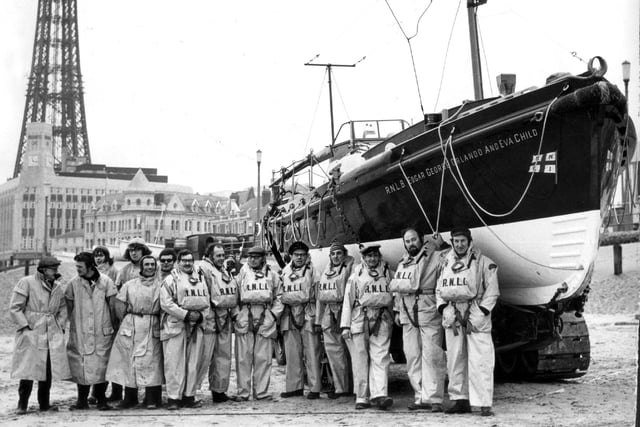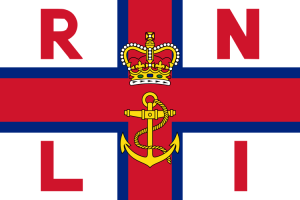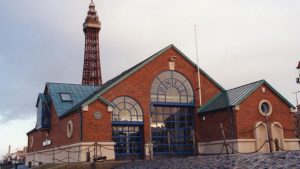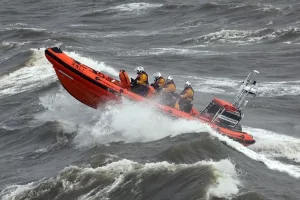When I was about 10-years old on holiday in Blackpool, Lancashire, England, we were awakened by a very loud explosion – it was the rocket call to the crew of the Blackpool lifeboat to launch the rescue boat into what was clearly a violently stormy night. Next day, my Mum and Dad took me and my brother to see the boat. I remember it’s small size and open deck. I wondered how such a tiny vessel could stay afloat in such a storm, and what the crew must have gone through to rescue the two men on a foundering fishing boat in Morcambe Bay on the Irish Sea. I’ve never forgotten that image.

Today, Island Chill Yacht Charters is proud to fly the flag of the British Royal National Lifeboat Institute in honor of their crews. On March 4th, 2024, the RNLI marked its 200th year of saving lives at sea, establishing one of the most remarkable maritime rescue traditions. Founded in 1823 by Sir William Hillary, the RNLI began with a simple yet profound mission: to save lives at sea. Hillary’s vision came from firsthand experience watching helplessly as ships wrecked off the Isle of Man’s treacherous waters of the Irish Sea. He knew there had to be a better way, and his determination gave birth to what would become a legacy of heroism.

Today, the RNLI’s distinctive red, blue and white flag flies proudly over the 238 lifeboat stations across the British Isles. The numbers tell an astounding story: RNLI crews have saved over 143,000 lives since their founding. Their crews launch in conditions that would keep most vessels safely in harbor, often facing howling winds and waves that tower over their boats.
But what makes this organization truly extraordinary isn’t just its longevity – it’s the fact that 95% of their organization is made up of volunteers; ordinary people – shopkeepers, teachers, office workers, and tradespeople – who drop everything at a moment’s notice, day or night, to literally rush into storm-tossed seas to save strangers.

The evolution of RNLI rescue vessels tells its own fascinating story of innovation and dedication. Take the Blackpool Lifeboat Station in Lancashire, established in 1864. In its early days, crews would launch heavy wooden rowboats into the Irish Sea’s fierce waves, with only their strength and determination to power them through rescue missions. Today, Blackpool operates three remarkable rescue vessels: a B class Atlantic 85 lifeboat named “William and Eleanor” capable of speeds up to 35 knots, and two D class inshore lifeboats, the “Basil Knighton” and “Dennis Smart.” Each vessel serves a crucial role in their rescue operations, from navigating shallow waters to conducting swift responses in rough seas.
The story of coxswain Keith Horrocks Sr. exemplifies the Blackpool station’s dedication. On a stormy night, Horrocks led his crew through 15-foot waves and Force 9 winds to rescue two fishermen whose vessel had capsized near Blackpool North Pier. The rescue took over three hours in treacherous conditions, with the all-volunteer crew making multiple attempts before successfully retrieving both men from the churning seas. I heard his unforgettable call to action.
The Blackpool Station averages over 100 launches each year. Crews face unique challenges that demand specialized training. The notorious tidal range of the Irish Sea can exceed 30 feet during spring tides, creating powerful currents around the three piers – iconic structures that pose significant rescue challenges. Crew members train to master the art of maneuvering their vessels between the pier supports, often in darkness and heavy surf. The station’s location presents another distinctive challenge: Blackpool’s famous beach stretches for seven miles but can transform from sandy playground to dangerous trap within hours as the tide rushes in across the shallow gradient. This means crew members must be experts at reading the local tide tables and understanding the complex sandbank systems that shift seasonally. Their training includes regular exercises in shallow water rescue techniques, with crews practicing their timing to navigate the razor-thin margin between sandbanks and incoming tide. And, in all weathers.

In winter, when violent storms batter the coast, the volunteer crew trains in some of the most challenging conditions imaginable. They routinely practice capsizing drills in the Atlantic 85, ensuring every team member can handle a vessel rollover in rough seas. The station’s newest crew members begin their journey with an intensive sea survival course in their full kit, learning to trust their equipment and each other in the churning waters off the Lancashire coast.
As we sail the Chesapeake Bay’s beautiful waters on Therapy, Tallawah and Irie Vibes, we share a connection with these brave men and women across the Atlantic. While our waters may be different, the commitment to maritime safety and the respect for the sea’s power unites us, thanks to the United States Coast Guard and Maryland Department of Natural Resources Police. The RNLI’s story reminds us that the maritime community is global, bound together by courage, compassion, and an unwavering commitment to helping those in peril on the sea. Their motto says it all: “With courage, nothing is impossible.”
